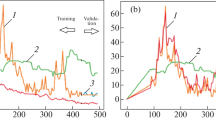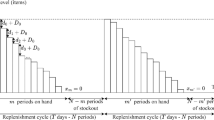Abstract
The solutions to real-life problems are challenging to find out in the exact form as the dimensions of the problems are significant. A multi-period multi-product inventory model is tested in this study through an artificial neural network for experiencing an uncertain environment. Whenever obstacles present in every period, a neural network with multithreading is one of the optimization procedures to find the best optimal solution with an inflation and time value of money. A fuzzy approach is used here to deal with the uncertainty, and the total cost of the system is calculated using the bi-objective constraint objective function. The first objective is to find the minimum cost of the system with the optimum space, which is the second objective. The solutions of the mathematical model are obtained by generating multiple threads that every thread is a possible solution. The numerical experiment chooses the best fit from the multiple solutions. An illustrative comparative study with the existing methodologies is provided. Results show that the proposed approach is the best for cost optimization and time minimization. It is found that the neural network with multithreading converges over other algorithms and the results obtain within less than 30% time of the existing algorithm.








Similar content being viewed by others
Explore related subjects
Discover the latest articles, news and stories from top researchers in related subjects.References
Kumar, R.K., Chandrawat, R.K., Sarkar, B., Joshi, V., Majumder, A.: An advanced optimization technique for smart production using α-cut based quadrilateral fuzzy number. Int. J. Fuzzy. Syst. 23, 107–127 (2021). https://doi.org/10.1007/s40815-020-01002-9
Bhuniya, S., Pareek, S., Sarkar, B.: A supply chain model with service level constraints and strategies under uncertainty. Alex. Eng. J. 60(6), 6035–6052 (2021). https://doi.org/10.1016/j.aej.2021.03.039
Chen, X., Simcha-Levi, D.: Coordinating inventory control and pricing strategies with random demand and fixed ordering cost: the infinite horizon case. Math. Oper. Res. 29(3), 698–723 (2004). https://doi.org/10.1287/moor.1040.0093
Chen, Y.F., Ray, S., Song, Y.: Optimal pricing and inventory control policy in periodic-review systems with fixed ordering cost and lost sales. Nav. Res. Loges. 53(2), 117–136 (2006). https://doi.org/10.1002/nav.20127
Lee, W.C., Wu, J.W., Lei, C.L.: Computational algorithmic procedure for optimal inventory policy involving ordering cost reduction and backorder discounts when lead time demand is controllable. App. Math. Comput. 189(1), 186–200 (2007). https://doi.org/10.1016/j.amc.2006.11.057
Chen, Y., Yang, S.: Time-varying effect of international iron ore price on China’s inflation: a complete price chain with TVP-SVAR-SV model. Resour. Policy. 73, 102200 (2021). https://doi.org/10.1016/j.resourpol.2021.102200
Ahmed, S., Akmal, U., Shapiro, A.: Coherent risk measures in inventory problems. Eur. J. Oper. Res. 182(1), 226–238 (2007). https://doi.org/10.1016/j.ejor.2006.07.016
Zhang, Y., Song, S., Zhang, H., Wu, C., Yin, W.: A hybrid genetic algorithm for two-stage multi-item inventory system with stochastic demand. Neur. Comput. Appl. 21(6), 1087–1098 (2012). https://doi.org/10.1007/s00521-011-0658-7
Taleizadeh, A.A., Niaki, S.T.A., Aryanezhad, M.B., Tafti, A.F.: A genetic algorithm to optimize multi-product multiconstraint inventory control systems with stochastic replenishment intervals and discount. Int. J. Adv. Manuf. Tech. 51(1), 311–323 (2010). https://doi.org/10.1007/s00170-010-2604-8
Das, S., Khan, M.A.A., Mahmoud, E.E., Abdel-Haleem, A., Abualnaja, K.M., Shaikh, A.A.: A production inventory model with partial trade credit policy and reliability. Alex. Eng. J. 60(1), 1325–1338 (2021). https://doi.org/10.1016/j.aej.2020.10.054
Tayyab, M., Sarkar, B.: An interactive fuzzy programming approach for a sustainable supplier selection under textile supply chain management. Comp. Indust. Eng. 155, 107164 (2021). https://doi.org/10.1016/j.cie.2021.107164
Dey, B.K., Bhuniya, S., Sarkar, B.: Involvement of controllable lead time and variable demand for a smart manufacturing system under a supply chain management. Exp. Syst. App. 184, 115464 (2021). https://doi.org/10.1016/j.eswa.2021.115464
Baughman, G., Rabinovich, S.: Capacity choice, monetary trade, and the cost of inflation. Eur. Econ. Rev. 134, 103698 (2021). https://doi.org/10.1016/j.euroecorev.2021.103698
Mahapatra, N.K., Maiti, M.: Decision process for multi-objective, multi-item production-inventory system via interactive fuzzy satisficing technique. Comp. Math. App. 49(5), 805–821 (2005). https://doi.org/10.1016/j.camwa.2004.07.020
Maity, K., Maiti, M.: A numerical approach to a multi-objective optimal inventory control problem for deteriorating multi-items under fuzzy inflation and discounting. Comp. Math. App. 55(8), 1794–1807 (2008). https://doi.org/10.1016/j.camwa.2007.07.011
Dey, J.K., Mondal, S.K., Maiti, M.: Two storage inventory problem with dynamic demand and interval valued lead-time over finite time horizon under inflation and time-value of money. Eur. J. Oper. Res. 185(1), 170–194 (2008). https://doi.org/10.1016/j.ejor.2006.12.037
Edalatpanah, S.A.: Neutrosophic structured element. Exp. Syst. 37(5), e12542 (2020). https://doi.org/10.1111/exsy.12542
Mirzazadeh, A., Ghomi, S.F.: Esfahani, MS: A multiple items inventory model under uncertain external inflationary conditions. Trend. App. Sci. Res. 6(5), 472 (2011)
Yadav, D., Kumari, R., Kumar, N., Sarkar, B.: Reduction of waste and carbon emission through the selection of items with cross-price elasticity of demand to form a sustainable supply chain with preservation technology. J. Clean. Prod. 297, 126298 (2021). https://doi.org/10.1016/j.jclepro.2021.126298
Ullah, M., Asghar, I., Zahid, M., Omair, M., Alarjani, A., Sarkar, B.: Ramification of remanufacturing in a sustainable three-echelon closed-loop supply chain management for returnable products. J. Clean. Prod. 290, 125609 (2021). https://doi.org/10.1016/j.jclepro.2020.125609
Deb, K., Mitra, K., Dewri, R., Majumdar, S.: Towards a better understanding of the epoxy-polymerization process using multi-objective evolutionary computation. Chem. Eng. Sci. 59(20), 4261–4277 (2004). https://doi.org/10.1016/j.ces.2004.06.012
Mousavi, S.M., Hajipour, V., Niaki, S.T.A., Alikar, N.: Optimizing multi-item multi-period inventory control system with discounted cash flow and inflation: Two calibrated meta-heuristic algorithms. App. Math. Model. 37(4), 2241–2256 (2013). https://doi.org/10.1016/j.apm.2012.05.019
Sadeghi, J., Niaki, S.T.A.: Two parameter tuned multi-objective evolutionary algorithms for a bi-objective vendor managed inventory model with trapezoidal fuzzy demand. App. Soft Comput. 30, 567–576 (2015). https://doi.org/10.1016/j.asoc.2015.02.013
Li, C.J., Chen, G.D., Sung, T.Y., Tsai, H.F.: Novel adaptive Kalman filter with fuzzy neural network for trajectory estimation system. Int. J. Fuzzy Syst. 21, 1649–1660 (2019). https://doi.org/10.1007/s40815-019-00686-y
Lin, Q., Chen, S., Lin, C.M.: An optimization method for the initial parameters selection of fuzzy cerebellar model neural networks in parametric fault diagnosis. Int. J. Fuzzy Syst. 22, 2071–2081 (2020). https://doi.org/10.1007/s40815-020-00908-8
Naderkhani, R., Behzad, M.H., Razzaghnia, T., Farnoosh, R.: Fuzzy regression analysis based on fuzzy neural networks using trapezoidal data. Int. J. Fuzzy Syst. (2021). https://doi.org/10.1007/s40815-020-01033-2
Fattahi, P., Hajipour, V., Nobari, A.: A bi-objective continuous review inventory control model: pareto-based meta-heuristic algorithms. App. Soft Comput. 32, 211–223 (2015). https://doi.org/10.1016/j.asoc.2015.02.044
Das, S.C., Manna, A.K., Rahman, M.S., Shaikh, A.A., Bhunia, A.K.: An inventory model for non-instantaneous deteriorating items with preservation technology and multiple credit periods-based trade credit financing via particle swarm optimization. Soft Comput. 25, 5365–5384 (2021). https://doi.org/10.1007/s00500-020-05535-x
Khurshid, B., Maqsood, S., Omair, M., Sarkar, B., Ahmed, I., Muhammad, K.: An improved evolution strategy hybridization with simulated annealing for permutation flow shop scheduling problems. IEEE Access. 9, 94505–94522 (2021). https://doi.org/10.1109/ACCESS.2021.3093336
Saha, S., Chatterjee, D., Sarkar, B.: The ramification of dynamic investment on the promotion and preservation technology for inventory management through a modified flower pollination algorithm. J. Retail. Consum. Ser. 58, 102326 (2021). https://doi.org/10.1016/j.jretconser.2020.102326
Jin, F., Liu, J., Zhou, L., Martínez, L.: Consensus-based linguistic distribution large-scale group decision making using statistical inference and regret theory. Group Dec. Negot. 30, 813–845 (2021). https://doi.org/10.1007/s10726-021-09736-z
Jin, F., Garg, H., Pei, L., Liu, J., Chen, H.: Multiplicative consistency adjustment model and data envelopment analysis-driven decision-making process with probabilistic hesitant fuzzy preference relations. Int. J. Fuzzy Syst. 22(7), 2319–2332 (2020). https://doi.org/10.1007/s40815-020-00944-4
Jin, F., Cao, M., Liu, J., Martínez, L., Chen, H.: Consistency and trust relationship-driven social network group decision-making method with probabilistic linguistic information. Appl. Soft Comput. 103, 107170 (2021). https://doi.org/10.1016/j.asoc.2021.107170
Jin, F., Ni, Z., Langari, R., Chen, H.: Consistency improvement-driven decision-making methods with probabilistic multiplicative preference relations. Group Dec. Negot. 29, 371–397 (2020). https://doi.org/10.1007/s10726-020-09658-2
Gupta, S., Haq, A., Ali, I., Sarkar, B.: Significance of multi-objective optimization in logistics problem for multi-product supply chain network under the intuitionistic fuzzy environment. Complex. Intell. Syst. (2021). https://doi.org/10.1007/s40747-021-00326-9
Taleizadeh, A.A., Moghadasi, H., Niaki, S.T.A., Eftekhari, A.: An EOQ-joint replenishment policy to supply expensive imported raw materials with payment in advance. J. App. Sci. 8(23), 4263–4273 (2008)
Daroudi, S., Kazemipoor, H., Najafi, E., Fallah, M.: The minimum latency in location routing fuzzy inventory problem for perishable multi-product materials. Appl. Soft. Comput. 110, 107543 (2021). https://doi.org/10.1016/j.asoc.2021.107543
Zhou, Y.: A novel similarity measure for generalized trapezoidal fuzzy numbers and its application to decision-making. Int. J. Ser. Sci. Tech. 9(3), 131–148 (2016). https://doi.org/10.14257/IJUNESST.2016.9.3.14
Mahapatra, A.M., Soni, H.N., Mahapatra, M.S., Sarkar, B., Majumder, S.: A continuous review production-inventory system with a variable preparation time in a fuzzy random environment. Mathematics 9(7), 747 (2021). https://doi.org/10.3390/math9070747
Omair, M., Noor, S., Tayyab, M., Maqsood, S., Ahmed, W., Sarkar, B., Habib, M.S.: The selection of the sustainable suppliers by the development of a decision support framework based on analytical hierarchical process and fuzzy inference system. Int. J. Fuzzy. Syst. (2021). https://doi.org/10.1007/s40815-021-01073-2
Das, S.K.: Multi item inventory model include lead time with demand dependent production cost and set-up-cost in fuzzy environment. J. Fuzzy Extend. App. 1(3), 241–258 (2020). https://doi.org/10.22105/JFEA.2020.254081.1025
Samanta, S., Dubey, V.K., Sarkar, B.: Measure of influences in social networks. App. Soft. Comput. 99, 106858 (2021). https://doi.org/10.1016/j.asoc.2020.106858
Sharma, S., Singh, S.R., Kumar, M.A.: Reverse logistics inventory model with multiple production and remanufacturing batches under fuzzy environment. RAIRO Oper. Res. 55(2), 571–588 (2021). https://doi.org/10.1051/ro/2021021
Garai, A., Chowdhury, S., Sarkar, B., Roy, T.K.: Cost-effective subsidy policy for growers and biofuels-plants in closed-loop supply chain of herbs and herbal medicines: An interactive bi-objective optimization in T-environment. Appl. Soft. Comput. 100, 106949 (2021). https://doi.org/10.1016/j.asoc.2020.106949
Glock, C.H., Schwindl, K., Jaber, M.Y.: An EOQ model with fuzzy demand and learning in fuzziness. Int. J. Serv. Oper. Manag. 12(1), 90–100 (2012). https://doi.org/10.1504/IJSOM.2012.046675
Sadeghi, J., Niaki, S.T.A., Malekian, M.R., Sadeghi, S.: Optimising multi-item economic production quantity model with trapezoidal fuzzy demand and backordering: two tuned meta-heuristics. Euro. J. Indust. Eng. 10(2), 170–195 (2016). https://doi.org/10.1504/EJIE.2016.075847
Hsu, M.J., Chien, Y.H., Wang, W.Y., Hsu, C.C.: A convolutional fuzzy neural network architecture for object classification with small training database. Int. J. Fuzzy Syst. 22, 1–10 (2020). https://doi.org/10.1007/s40815-019-00764-1
Acknowledgements
This work was supported (in part) by the Yonsei University Research Fund (Post Doc. Researcher Supporting Program) of 2020 (project no.: 2020-12-0136). The work is supported by the National Research Foundation of Korea (NRF) grant, funded by the Korea Government (MSIT) (NRF-2020R1F1A1064460).
Author information
Authors and Affiliations
Corresponding author
Rights and permissions
About this article
Cite this article
Sarkar, A., Guchhait, R. & Sarkar, B. Application of the Artificial Neural Network with Multithreading Within an Inventory Model Under Uncertainty and Inflation. Int. J. Fuzzy Syst. 24, 2318–2332 (2022). https://doi.org/10.1007/s40815-022-01276-1
Received:
Revised:
Accepted:
Published:
Issue Date:
DOI: https://doi.org/10.1007/s40815-022-01276-1




